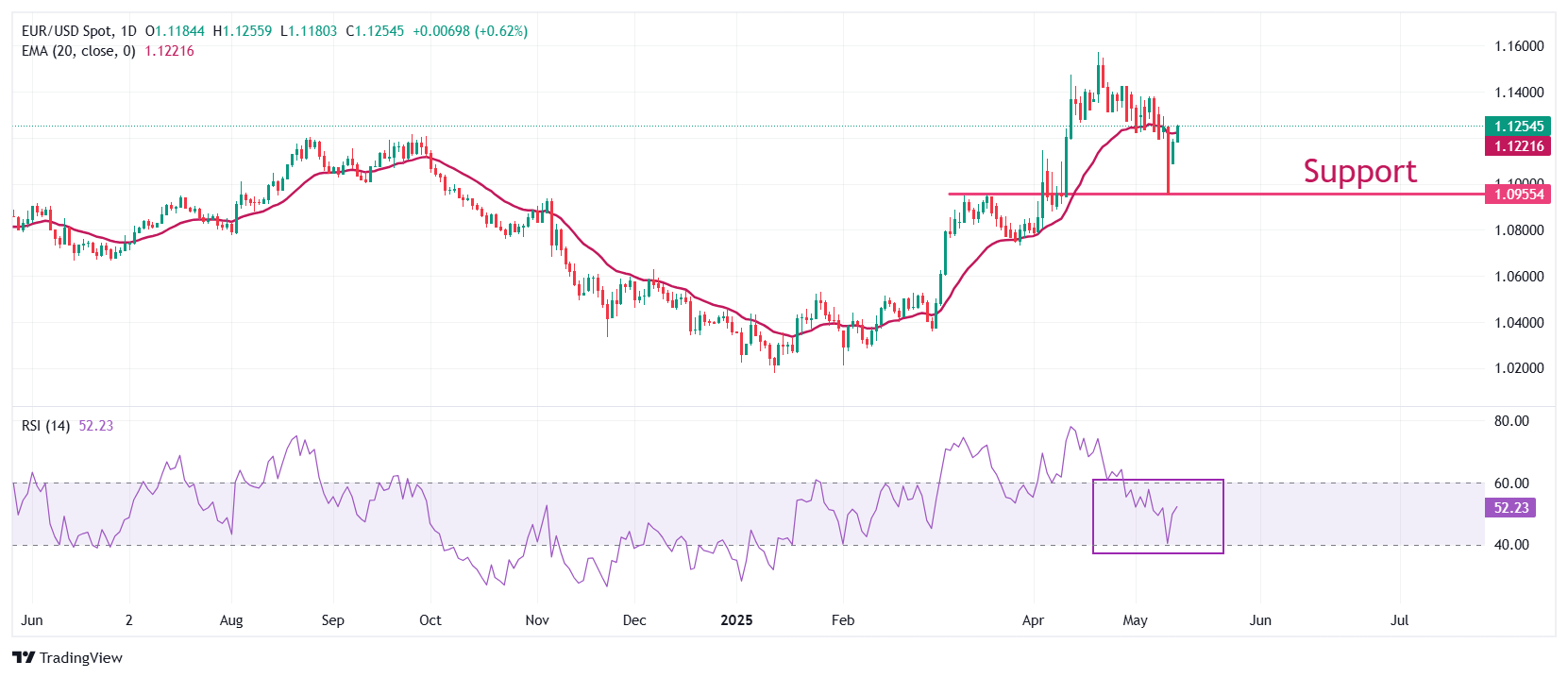- The EUR/USD is recovered about 1,1250 while the US dollar suffers after the publication of US inflation data for April, which were softer than expected.
- The president of the USA, Donald Trump, again criticized the president of the Fed, Jerome Powell, for not lowering interest rates.
- François Villeroy, a member of the ECB, says he has hopes of another interest rate cut before summer ends.
The EUR/USD moves up to 1,1250 during the European negotiation hours on Wednesday, extending the profits on Tuesday. The main currency pair has attracted significant offers at the expense of the US dollar (USD), with the dollar index (DXY) – which measures the value of the dollar against six main currencies – extending its setback from the monthly maximum of 102.00 to around 100.50.
The dollar suffers since the US president, Donald Trump, criticized the Federal Reserve (Fed) for not lowering interest rates after the publication of the data of the April Consumer Price Index (CPI) of April, which were softer than expected, on Tuesday. The data showed that the general CPI rose 2.3%, the lowest level in more than four years.
“Without inflation, and gasoline prices, energy, edible and practically everything else, are down! The Fed must lower the rate, as Europe and China have done!” Trump said in a publication in Truth Social and added: “What happens to Too Late Powell? It is not fair for America, which is ready to bloom. Just let everything happen, it will be something beautiful!”
Despite the slowdown in inflationary pressures and calls for interest rate cuts by President Trump, operators have not reduced bets that support the Fed to cut interest rates before the September policy meeting. According to the CME Fedwatch tool, the probability that the Fed maintain stable interest rates in the range of 4.25% -4.50% in July has fallen marginally to 63.3% from 65.1% seen on Tuesday.
It seems that an improvement in US economic perspectives due to the agreement with China for a temporary commercial truce has absorbed the impact of inflationary pressures on cooling. On Monday, the US and China agreed to avoid a large -scale commercial war and reduce tariffs by 115 percentage points.
What moves the market today: EUR/USD gains ground despite the solid moderate bets of the ECB
- The EUR/USD advances significantly due to a strong correction in the US dollar. The euro (EUR) is negotiated in front of its peers, except the Japanese yen (JPY), Wednesday. The main currency pair performs strongly despite the fact that officials of the European Central Bank (ECB) continue to emphasize the need to reduce interest rates even more in the midst of a growing confidence that US tariff policies will not increase inflation in the eurozone. Theoretically, lower interest rates by the ECB are bad for the euro.
- “We do not see that inflation recovers. The protectionism of the Trump administration will lead to a restart of inflation in the US, but not in Europe, which will probably allow another cut of rates for summer,” said ECB’s policies and governor of the Bank of France, François Villery de Galhau, according to Reuters.
- Meanwhile, investors seek new clues about the progress of commercial conversations between the US and the European Union (EU). Investors have become anxious due to the absence of comments from the White House about any progress in commercial conversations with the commercial block, assuming slow efforts by the European Commission (EC) to solve commercial problems.
- This week, the main trigger for the pair of shared currencies will be the speech of the president of the FED, Powell, at the Thomas Laubach Research Conference in Washington on Thursday. President Powell is expected to provide new orientations on monetary policy perspectives following a temporary truce between the US and China.
- In the economic field, investors will focus on retail sales data and the production price index (IPP) for April, which will be published on Thursday.
Technical analysis: EUR/USD is recovered about 1,1250

EUR/USD extends its recovery about 1,1250 on Wednesday. The pair bounces strongly and recovers above the 20 -day exponential (EMA) mobile average, which is negotiated around 1,1220, suggesting that the trend has become bullish.
The relative force index (RSI) of 14 periods is recovered strongly from 40.00, suggesting that the upward trend is maintained.
Looking up, the maximum of April 28, 1,1425 will be the main resistance for the pair. On the contrary, the maximum of March 11, 1,0950 will be a key support for the euros of the euro.
Euro Faqs
The euro is the currency of the 19 countries of the European Union that belong to the Eurozone. It is the second most negotiated currency in the world, behind the US dollar. In 2022, it represented 31 % of all foreign exchange transactions, with an average daily business volume of more than 2.2 billion dollars a day. The EUR/USD is the most negotiated currency pair in the world, with an estimate of 30 %of all transactions, followed by the EUR/JPY (4 %), the EUR/GBP (3 %) and the EUR/AU (2 %).
The European Central Bank (ECB), based in Frankfurt (Germany), is the Eurozone reserve bank. The ECB establishes interest rates and manages monetary policy. The main mandate of the ECB is to maintain price stability, which means controlling inflation or stimulating growth. Its main tool is the rise or decrease in interest rates. Relatively high interest rates (or the expectation of higher types) usually benefit the euro and vice versa. The GOVERNMENT BOOK of the ECB makes decisions about monetary policy in meetings that are held eight times a year. The decisions are made by the directors of the National Banks of the Eurozone and six permanent members, including the president of the ECB, Christine Lagarde.
Eurozone inflation data, measured by the harmonized consumer prices index (IPCA), are an important economic indicator for the euro. If inflation increases more than expected, especially if it exceeds 2% of the ECB, it forces the ECB to rise interest rates to control it again. Relatively high interest rates compared to their counterparts usually benefit the euro, since they make the region more attractive as a place for global investors to deposit their money.
Published data measure the health of the economy and can have an impact on the euro. Indicators such as GDP, manufacturing and services PMIs, employment and consumer trust surveys can influence the direction of the single currency. A strong economy is good for the euro. Not only attracts more foreign investment, but it can encourage the ECB to raise interest rates, which will directly strengthen the euro. Otherwise, if economic data is weak, the euro is likely to fall. The economic data of the four largest economies in the euro zone (Germany, France, Italy and Spain) are especially significant, since they represent 75% of the economy of the euro area.
Another important fact that is published on the euro is the commercial balance. This indicator measures the difference between what a country earns with its exports and what you spend on imports during a given period. If a country produces highly demanded export products, its currency will gain value simply by the additional demand created by foreign buyers seeking to buy those goods. Therefore, a positive net trade balance strengthens a currency and vice versa in the case of a negative balance
Source: Fx Street
I am Joshua Winder, a senior-level journalist and editor at World Stock Market. I specialize in covering news related to the stock market and economic trends. With more than 8 years of experience in this field, I have become an expert in financial reporting.







